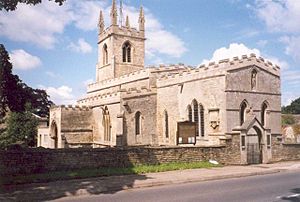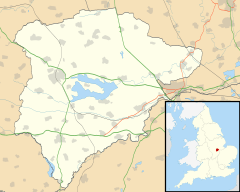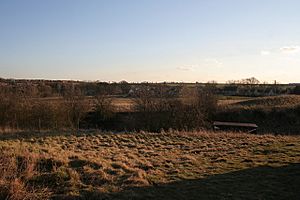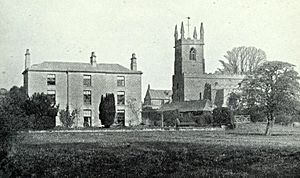Great Casterton facts for kids
Quick facts for kids Great Casterton |
|
|---|---|
 Church of St Peter and St Paul, Great Casterton |
|
| Area | 3.6 sq mi (9.3 km2) |
| Population | 600 (Including Tickencote)2011 Census |
| • Density | 121/sq mi (47/km2) |
| OS grid reference | TF005090 |
| • London | 83 miles (134 km) SSE |
| Unitary authority | |
| Shire county | |
| Ceremonial county | |
| Region | |
| Country | England |
| Sovereign state | United Kingdom |
| Post town | STAMFORD |
| Postcode district | PE9 |
| Dialling code | 01780 |
| Police | Leicestershire |
| Fire | Leicestershire |
| Ambulance | East Midlands |
| EU Parliament | East Midlands |
| UK Parliament |
|
Great Casterton is a small village in the county of Rutland, England. It is also a civil parish, which is a local area with its own council. The village is special because it sits where an old Roman road called Ermine Street crosses the River Gwash.
Contents
Exploring Great Casterton's Location
Great Casterton is about three miles north-west of Stamford. It is very close to the border of Lincolnshire. The village of Tickencote is just to the north.
The village's edge, called the parish boundary, mostly follows the River Gwash to the south and east. The main road, the A1, used to go right through the village. But in 1960, a new road was built around Stamford. Now, the old road through the village is called the B1081.
There is a tiny nature reserve near the village called Great Casterton Road Banks. Here, you can find rare plants like Sulphur Clover and Greater Broomrape.
A Glimpse into Great Casterton's Past
The name 'Casterton' means 'farm or settlement near a Roman site'. This tells us a lot about the village's long history.
The first settlement here was a Roman fort, built around 44 AD. Over time, a town grew up around the fort. This town later had walls for protection. You can still see parts of these old defences today. People have dug up the area to learn more about the Roman town. They found a Roman villa near the River Gwash and also old burial sites, including some from early Anglo-Saxons.
About two miles north of the town, you can find the remains of Woodhead Castle. This was a medieval castle with a ditch (moat) around it and a protected yard (bailey).
The village church is called St Peter & St Paul. It is a very old and important building, listed as a Grade I listed building. This means it is a building of special historical interest.
To enter the churchyard, you walk through an arched war memorial. This memorial remembers the people from the village who died in the World Wars. The church shares its priest with nearby villages like Pickworth and Little Casterton. The famous poet John Clare got married in this church in 1820.
Life and Learning in Great Casterton
Great Casterton has schools for different age groups. There is a primary school called Great Casterton Church of England Primary School. For older students, there is a secondary school called Casterton College.
The village also has a pub, which is a traditional English place to eat and drink. It is called the Crown Inn.
See also
 In Spanish: Great Casterton para niños
In Spanish: Great Casterton para niños




